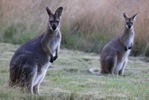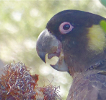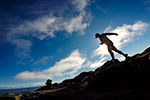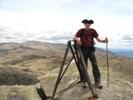As bushwalkers what can we do to help with regeneration?
Forum rules
The place for bushwalking topics that are not location specific.
The place for bushwalking topics that are not location specific.
39 posts
• Page 1 of 2 • 1, 2
As bushwalkers what can we do to help with regeneration?
After the fires die and areas start to open up do people have any suggestions?
Apart from not doing any further damage by cutting corners and making new tracks could we help out by taking seedlings or seeds and making plantings?
Take along rolls of hessian cut into low fence height and making ash dams to keep nutrients in place?
I don't have any real answers myself but I have a gut feeling that any of the present governments are going to do nothing
Apart from not doing any further damage by cutting corners and making new tracks could we help out by taking seedlings or seeds and making plantings?
Take along rolls of hessian cut into low fence height and making ash dams to keep nutrients in place?
I don't have any real answers myself but I have a gut feeling that any of the present governments are going to do nothing
Ve are too soon old und too late schmart
- Moondog55
- Lagarostrobos franklinii

- Posts: 11256
- Joined: Thu 03 Dec, 2009 4:15 pm
- Location: Norlane Geelong Victoria Australia
- Region: Victoria
- Gender: Male
Re: As bushwalkers what can we do to help with regeneration?
Fire, actually the smoke leaves a coating on many native plant seeds, this coating is essential for the seed to strike.
I think native plants will do all right by themselves.
I agree with you, it’s the seeds along the edges of the existing tracks that might struggle with pedestrians
Sent from my iPhone using Tapatalk Pro
I think native plants will do all right by themselves.
I agree with you, it’s the seeds along the edges of the existing tracks that might struggle with pedestrians
Sent from my iPhone using Tapatalk Pro
- weeds
- Athrotaxis cupressoides

- Posts: 338
- Joined: Tue 31 Mar, 2015 5:29 am
- Region: Queensland
- Gender: Male
Re: As bushwalkers what can we do to help with regeneration?
Adjust your bush-walking mentality to instead meet up with a local council bush-regeneration site. These are normally only 3 hours per site, per month. I have also done this when I had a spare day in NZ prior to going mountaineering for a week. I have also volunteered as a one-off in other council areas in Sydney, just to meet people (and remove sometimes flammable weeds), as well as throughout the Blue Mountains City Council area.
My primary Landcare group's area is currently being devastated by the month-long fires in the Wollemi National Park and Capertee Valley catchment. I never dealt with seedlings, seeds or plants... we only treated weeds that have spread into the National Park. These were usually 2 or 3 day trips.
Parks Victoria would advise you better. https://www.parkconnect.vic.gov.au/
My primary Landcare group's area is currently being devastated by the month-long fires in the Wollemi National Park and Capertee Valley catchment. I never dealt with seedlings, seeds or plants... we only treated weeds that have spread into the National Park. These were usually 2 or 3 day trips.
Parks Victoria would advise you better. https://www.parkconnect.vic.gov.au/
Live everyday as if it were your last... one day you will be right.
- Wollemi
- Athrotaxis cupressoides

- Posts: 281
- Joined: Tue 24 Jul, 2012 10:32 am
- Location: lower Blue Mts
- Region: New South Wales
- Gender: Male
Re: As bushwalkers what can we do to help with regeneration?
I am so ticked off with Parks VIC at the moment that I would prefer to never speak to them again if possible.
Ditto the Greater Geelong council whose mind-set is stuck in the 1950s still
Ditto the Greater Geelong council whose mind-set is stuck in the 1950s still
Ve are too soon old und too late schmart
- Moondog55
- Lagarostrobos franklinii

- Posts: 11256
- Joined: Thu 03 Dec, 2009 4:15 pm
- Location: Norlane Geelong Victoria Australia
- Region: Victoria
- Gender: Male
Re: As bushwalkers what can we do to help with regeneration?
Sadly there's not really anything significant that anyone can do. One way or the other nature will take its course, but a lot will depend on rainfall regimes moving forward. I suspect there will be some significant changes to the affected forests - the rainforests that have burnt are probably history now.
- Hughmac
- Athrotaxis cupressoides

- Posts: 156
- Joined: Sat 14 Apr, 2012 9:20 pm
- Region: New South Wales
Re: As bushwalkers what can we do to help with regeneration?
Hughmac wrote:Sadly there's not really anything significant that anyone can do. One way or the other nature will take its course, but a lot will depend on rainfall regimes moving forward. I suspect there will be some significant changes to the affected forests - the rainforests that have burnt are probably history now.
Hughmac, if people got together and planted rainforest plants in the areas burnt how likely is the rainforest area to recover and once again become rainforest?
-

wildwanderer - Athrotaxis selaginoides

- Posts: 1640
- Joined: Tue 02 May, 2017 8:42 am
- Location: Out of lockdown \o/
- Region: New South Wales
- Gender: Male
Re: As bushwalkers what can we do to help with regeneration?
wildwanderer wrote:If people got together and planted rainforest plants in the areas burnt how likely is the rainforest area to recover and once again become rainforest?
It's not impossible. If people get in early, plant and establish rainforest plants to give them a head start, they'd probably have a reasonable chance of competing with the non-rainforest (sclerophyllous) plants. Remember too, that just because the rainforest has been burnt, doesn't mean it's a write-off; if it was a cooler and less intense burn (or RFS dumped a tanker-load of water in the right spot), the rainforest has a pretty good chance of regenerating.
The problem most likely is going to be controlling the re-growth of gum-trees and a Acacias, and if it's not done carefully, you'd run the risk of creating a more degraded system that exotic species can invade more easily.
A lot (IMO) is going to depend on when the next major rain is and how much we get... If it's a long way until we get substantial rain, that will really hamper the regrowth of the burnt rainforest.
- LachlanB
- Athrotaxis cupressoides

- Posts: 381
- Joined: Mon 21 Apr, 2014 5:07 pm
- Region: New South Wales
- Gender: Male
Re: As bushwalkers what can we do to help with regeneration?
Moondog55 wrote:After the fires die and areas start to open up do people have any suggestions?
Hi Moondog, thanks for starting this thread. I’ve been thinking the same thing in the last week - concerned also for the animals who may have survived the fire but will not survive the famine to come. So I put a call out on Facebook for any organisations or people who need help and/or money to help wild animals recover from the fires, particularly in NSW where we have historically done all our bushwalking.
- FAWNA on the north coast of NSW are setting Food4Wildlife stations and need financial support to buy feed for wild animals. FAWNA usually do not advocate feeding wild animals but the current situation is so unprecedented they are feeding wildlife until much needed rains arrive. https://www.fawna.org.au/food-4-wildlif ... coast-lga/
- The Animal Rescue Collective - lookup #bushtuckerbox - DESPERATELY NEED QUALITY NEST BOXES FOR ANIMALS / BIRDS, Insect houses etc for placement in burnt areas. https://m.facebook.com/groups/mkcfreecy ... view=group. They also are looking for people who can go into burnt areas (by foot or vehicle) to put food. There's several makers groups in there. Or people can set up distribution points like a #bushtuckerbox in their area.
If anyone has any others please let me know. I’ll also post any more as they may come to hand, but both these seem like good initiatives in these unusual times.
-

awildland - Athrotaxis cupressoides

- Posts: 285
- Joined: Tue 04 Dec, 2012 6:34 am
- Location: Hobart
- Region: Tasmania
Re: As bushwalkers what can we do to help with regeneration?
Food and water stations sound like a very good idea as does the idea of adding in nesting boxes.
I must admit tho that I was thinking more along the lines of tubestock and some sort of biodegradable watering station to assist in plant establishment
I must admit tho that I was thinking more along the lines of tubestock and some sort of biodegradable watering station to assist in plant establishment
Ve are too soon old und too late schmart
- Moondog55
- Lagarostrobos franklinii

- Posts: 11256
- Joined: Thu 03 Dec, 2009 4:15 pm
- Location: Norlane Geelong Victoria Australia
- Region: Victoria
- Gender: Male
Re: As bushwalkers what can we do to help with regeneration?
Next expected rainfall of any real consequence is not till March/April ....
Any feeding/watering would have to be maintain at least untill then...
Any feeding/watering would have to be maintain at least untill then...
-

Warin - Athrotaxis selaginoides

- Posts: 1463
- Joined: Sat 11 Nov, 2017 8:02 am
- Region: New South Wales
Re: As bushwalkers what can we do to help with regeneration?
Warin wrote:Next expected rainfall of any real consequence is not till March/April ....
Any feeding/watering would have to be maintain at least untill then...
I get the feeling that is something people are prepared to do, particularly those on the ground living in these affected areas. Hopefully those of us not affected, or not able to help on the ground, can continue to provide them with financial support. ❤️
-

awildland - Athrotaxis cupressoides

- Posts: 285
- Joined: Tue 04 Dec, 2012 6:34 am
- Location: Hobart
- Region: Tasmania
Re: As bushwalkers what can we do to help with regeneration?
Moondog55 wrote:Food and water stations sound like a very good idea as does the idea of adding in nesting boxes.
I must admit tho that I was thinking more along the lines of tubestock and some sort of biodegradable watering station to assist in plant establishment
Hey Moondog, I knew you were thinking about the plants etc and I also think that is really important. This has been such a deep, widespread event. I shall also keep my ear to the ground for anyone doing replanting work etc. and post anything I find.
I think the suggestion about Landcare groups is a good one. I know there are people out there as passionate about saving our forest and rainforests as there are people caring about the animals.
-

awildland - Athrotaxis cupressoides

- Posts: 285
- Joined: Tue 04 Dec, 2012 6:34 am
- Location: Hobart
- Region: Tasmania
Re: As bushwalkers what can we do to help with regeneration?
I keep reading that koalas will be functionally extinct unless we do massive habitat regeneration immediately, if koalas then I'd assume a lot of other smaller animals, insects birds and small reptiles. Whole ecosytems will need help I think.
Personally I would support an increase in the GST rate to pay for this if it was temporary, [ say 3 to 5 years] unfortunately politicians almost always think about taxation increases as being permanent
Personally I would support an increase in the GST rate to pay for this if it was temporary, [ say 3 to 5 years] unfortunately politicians almost always think about taxation increases as being permanent
Ve are too soon old und too late schmart
- Moondog55
- Lagarostrobos franklinii

- Posts: 11256
- Joined: Thu 03 Dec, 2009 4:15 pm
- Location: Norlane Geelong Victoria Australia
- Region: Victoria
- Gender: Male
Re: As bushwalkers what can we do to help with regeneration?
GST is a regressive tax.
- CraigVIC
- Phyllocladus aspleniifolius

- Posts: 606
- Joined: Tue 24 Oct, 2017 6:20 pm
- Region: Victoria
Re: As bushwalkers what can we do to help with regeneration?
CraigVIC wrote:GST is a regressive tax.
Most probably but what do you suggest? This work will take a generation and trillions of dollars
Ve are too soon old und too late schmart
- Moondog55
- Lagarostrobos franklinii

- Posts: 11256
- Joined: Thu 03 Dec, 2009 4:15 pm
- Location: Norlane Geelong Victoria Australia
- Region: Victoria
- Gender: Male
Re: As bushwalkers what can we do to help with regeneration?
https://www.facebook.com/groups/2169261 ... ?ref=share
Drought Garden Recovery Project Australia.
This might be a worthwhile group for anyone interested.
Drought Garden Recovery Project Australia.
This might be a worthwhile group for anyone interested.
-

awildland - Athrotaxis cupressoides

- Posts: 285
- Joined: Tue 04 Dec, 2012 6:34 am
- Location: Hobart
- Region: Tasmania
Re: As bushwalkers what can we do to help with regeneration?
Moondog55 wrote:CraigVIC wrote:GST is a regressive tax.
Most probably but what do you suggest? This work will take a generation and trillions of dollars
I suggest we address the root cause without delay. We don't have any problem developing mechanisms to do that having been coming up with them since Howard was PM.
As for taxes to support regeneration I simply don't see it. We've just been through an election with Labor showing how much money could be raised by capturing foregone revenue. There was no appetite for it. The idea of going even futher to a large new tax seems a flight of fancy. Especially as it cannot be hypothecated. There will be a massive bill rebuilding communities that will come before any bush regeneration. You live in Victoria. You'll be aware despite being the most progressive state in the nation many, mamy people are actively campaigning against National parks. There are many fair ways the money could be raised but it won't be.
- CraigVIC
- Phyllocladus aspleniifolius

- Posts: 606
- Joined: Tue 24 Oct, 2017 6:20 pm
- Region: Victoria
Re: As bushwalkers what can we do to help with regeneration?
Just wondering aloud here...
It might be a good time to deal decisively with feral animals while the drought and fires have reduced their numbers and weakened them, and when the recovering native animals would benefit the most from the absence of ferals. Maybe, after the fires, there could be an "open weekend" when shooters can enter the national parks and kill any feral animal.
It might be a good time to deal decisively with feral animals while the drought and fires have reduced their numbers and weakened them, and when the recovering native animals would benefit the most from the absence of ferals. Maybe, after the fires, there could be an "open weekend" when shooters can enter the national parks and kill any feral animal.
-

ribuck - Athrotaxis selaginoides

- Posts: 1900
- Joined: Wed 15 May, 2013 3:47 am
- Region: Other Country
- Gender: Male
Re: As bushwalkers what can we do to help with regeneration?
ribuck wrote:Just wondering aloud here...
It might be a good time to deal decisively with feral animals while the drought and fires have reduced their numbers and weakened them, and when the recovering native animals would benefit the most from the absence of ferals. Maybe, after the fires, there could be an "open weekend" when shooters can enter the national parks and kill any feral animal.
I like the idea Not sure it would work but it would be worth trying, more so tho in the areas surrounding the burnt out parts.
Ve are too soon old und too late schmart
- Moondog55
- Lagarostrobos franklinii

- Posts: 11256
- Joined: Thu 03 Dec, 2009 4:15 pm
- Location: Norlane Geelong Victoria Australia
- Region: Victoria
- Gender: Male
Re: As bushwalkers what can we do to help with regeneration?
Seems like a suggestion that's well worth passing on to the various environment management departments.
- peregrinator
- Athrotaxis selaginoides

- Posts: 1814
- Joined: Fri 15 Apr, 2011 2:50 pm
- Region: Victoria
Re: As bushwalkers what can we do to help with regeneration?
Given that we are now seeing the effects of climate change that in the medium term will only get worse and cannot be reversed in a persons lifetime, it is blatantly obvious that our bushland will undergo massive changes and what we are used to seeing will be replaced by something different, thats simply how ecosystems work.
Its probably a human trait to try and fight nature in an effort to maintain "what was", and these efforts will always fail, if conditions have changed then its inevitable.
So the replanting idea will fail. If nature cannot regenerate then artificial regeneration will fail...the next bushfire will wipe it all out.
On this bushwalking forum we have a group that is probably closer to nature than the average random group, yet the basics of ecological adaption are not widely understood here. So the average joe public will have less clues. This will allow our politicians to do things that appeal to an ill educated public that have immediate TRENDY appeal, rather than tackle the hard issues raised by climate change, much less tackle climate change itself.
Be carefull what you wish for.
Its probably a human trait to try and fight nature in an effort to maintain "what was", and these efforts will always fail, if conditions have changed then its inevitable.
So the replanting idea will fail. If nature cannot regenerate then artificial regeneration will fail...the next bushfire will wipe it all out.
On this bushwalking forum we have a group that is probably closer to nature than the average random group, yet the basics of ecological adaption are not widely understood here. So the average joe public will have less clues. This will allow our politicians to do things that appeal to an ill educated public that have immediate TRENDY appeal, rather than tackle the hard issues raised by climate change, much less tackle climate change itself.
Be carefull what you wish for.
- ghosta
- Atherosperma moschatum

- Posts: 61
- Joined: Thu 03 Sep, 2009 8:54 pm
- Region: Tasmania
- Gender: Male
Re: As bushwalkers what can we do to help with regeneration?
ribuck wrote:Just wondering aloud here...
It might be a good time to deal decisively with feral animals while the drought and fires have reduced their numbers and weakened them, and when the recovering native animals would benefit the most from the absence of ferals. Maybe, after the fires, there could be an "open weekend" when shooters can enter the national parks and kill any feral animal.
The farmers are out 'putting down' their injured stock. The same should be done for other animals.
Amateur shooters won't get far in a weekend, nor will they be that prolific. The resource that could be used is the Army - trained sharp shooters with choppers. As there should be on one in these burn out areas it could be a good time to target feral animals too, giving the natives a better go at survival.
Last edited by Warin on Thu 09 Jan, 2020 2:36 pm, edited 1 time in total.
-

Warin - Athrotaxis selaginoides

- Posts: 1463
- Joined: Sat 11 Nov, 2017 8:02 am
- Region: New South Wales
Re: As bushwalkers what can we do to help with regeneration?
I like the army shooting feral animals idea. Could be done all year long as training exercises, a properly organised military only shooting in national parks exemption that I could agree with.
By properly organised I mean systematically sweeping through the landscape.
By properly organised I mean systematically sweeping through the landscape.
- Neo
- Athrotaxis selaginoides

- Posts: 1893
- Joined: Wed 31 Aug, 2016 4:53 pm
- Location: Port Macquarie NSW
- Region: New South Wales
- Gender: Male
Re: As bushwalkers what can we do to help with regeneration?
ghosta wrote:Be carefull what you wish for.
I'm not sure what you mean to imply or suggest with your last sentence in the context of my initial query ghosta.
Most of us here are aware of what happens after a normal fire in our Alpine regions and the status of Alpine Ash and Mountain Ash as the worlds tallest weeds. Are you suggesting that we don't install ash fences or attempt anything?
As a gardener I can think of few minimum impact things that would help in the short term that would not cost a lot of money prior to the first big rains
Ve are too soon old und too late schmart
- Moondog55
- Lagarostrobos franklinii

- Posts: 11256
- Joined: Thu 03 Dec, 2009 4:15 pm
- Location: Norlane Geelong Victoria Australia
- Region: Victoria
- Gender: Male
Re: As bushwalkers what can we do to help with regeneration?
Warin wrote:ribuck wrote:Just wondering aloud here...
It might be a good time to deal decisively with feral animals while the drought and fires have reduced their numbers and weakened them, and when the recovering native animals would benefit the most from the absence of ferals. Maybe, after the fires, there could be an "open weekend" when shooters can enter the national parks and kill any feral animal.
The farmers are out 'putting down' their injured stock. The same should be done for other animals.
Amateur shooters won't get far in a weekend, nor will they be that prolific. The resource that could be used is the Army - trained sharp shooters with choppers. As there should be on one in these burn out areas it could be a good time to target feral animals too, giving the natives a better go at survival.
Coordinated effects from local shooting/hunting clubs have long proven vastly more effective than most government programs, but efforts need to be sustained long term to make a real dent. Access to National Parks would be controversial of course, would need to be officially coordinated rather than a free or all. The Victorian bounty program has been quite successful with foxes and goats, would be good to see it widened to feral cats but that's just way too open for abuse eg. pets being killed for money.
Agreed that the denuded forests present both a risk and opportunity to make a dent in feral animal populations before they take advantage of the lack of forest cover. Don't see helicopters really working though, other than for surveying purposes. Skilled operators in helicopters with drum-fed shotguns work well on feral pigs over marshes and other low vegetation, but that's no good for goats, foxes or cats over trees, no matter how bare the canopy.
Oh and no offense to the Army, but I'd trust the abilities of a seasoned farmer or deer hunter first. Whole different type of shooting
-

headwerkn - Phyllocladus aspleniifolius

- Posts: 657
- Joined: Sat 09 Nov, 2013 3:50 pm
- Region: Tasmania
- Gender: Male
Re: As bushwalkers what can we do to help with regeneration?
One of my concerns about post-fire wilderness is the ease with which weeds can take hold.
The ground around the first few km of the Moses Creek Track in the Walls of Jerusalem is now 100% covered in weeds after the native ground cover was destroyed in a bushfire. I was shocked when I walked in that way about a year ago, for the first time in years.
Were the weed seeds brought in on the clothing of bushwalkers? I do not know. But it's a possibility. Could also be from nearby forestry works. Either way, it's a disaster.
The ground around the first few km of the Moses Creek Track in the Walls of Jerusalem is now 100% covered in weeds after the native ground cover was destroyed in a bushfire. I was shocked when I walked in that way about a year ago, for the first time in years.
Were the weed seeds brought in on the clothing of bushwalkers? I do not know. But it's a possibility. Could also be from nearby forestry works. Either way, it's a disaster.
- Son of a Beach
- Lagarostrobos franklinii

- Posts: 7060
- Joined: Thu 01 Mar, 2007 7:55 am
- ASSOCIATED ORGANISATIONS: Bit Map (NIXANZ)
- Region: Tasmania
- Gender: Male
- cur3n4
- Nothofagus cunninghamii

- Posts: 1
- Joined: Tue 07 Jan, 2020 7:19 pm
- Region: New South Wales
Re: As bushwalkers what can we do to help with regeneration?
Son of a Beach wrote:One of my concerns about post-fire wilderness is the ease with which weeds can take hold.
The ground around the first few km of the Moses Creek Track in the Walls of Jerusalem is now 100% covered in weeds after the native ground cover was destroyed in a bushfire. I was shocked when I walked in that way about a year ago, for the first time in years.
Were the weed seeds brought in on the clothing of bushwalkers? I do not know. But it's a possibility. Could also be from nearby forestry works. Either way, it's a disaster.
Do you know which weed species Nik? I've been a volunteer bush regenerator in NSW Blue Mountains for about 15 years. The seed of some noxious weeds such as Gorse and Broom can remain viable in the ground for up to 80 years. They quickly and rampantly activate after a bushfire; you should see the mess we have had to deal with over the years. Hypothetically I guess seeds with that type of longevity in WOJ could even have been introduced by trappers or graziers working/living up there, as they did, in the 1930s/40s?
John W
In Nature's keeping they are safe, but through the agency of man destruction is making rapid progress - John Muir c1912
In Nature's keeping they are safe, but through the agency of man destruction is making rapid progress - John Muir c1912
-

johnw - Lagarostrobos franklinii

- Posts: 9382
- Joined: Wed 23 Jan, 2008 11:59 am
- Location: Macarthur Region - SW Sydney
- Region: New South Wales
- Gender: Male
Re: As bushwalkers what can we do to help with regeneration?
Struth 80 years!
I'd only heard of
"one year of weeds equals seven years of seeds"!
Edit, I also know some seeds take a good six months to germinate, others are up in three days.
I'd only heard of
"one year of weeds equals seven years of seeds"!
Edit, I also know some seeds take a good six months to germinate, others are up in three days.
- Neo
- Athrotaxis selaginoides

- Posts: 1893
- Joined: Wed 31 Aug, 2016 4:53 pm
- Location: Port Macquarie NSW
- Region: New South Wales
- Gender: Male
Re: As bushwalkers what can we do to help with regeneration?
johnw wrote:Son of a Beach wrote:One of my concerns about post-fire wilderness is the ease with which weeds can take hold.
The ground around the first few km of the Moses Creek Track in the Walls of Jerusalem is now 100% covered in weeds after the native ground cover was destroyed in a bushfire.Do you know which weed species Nik?
I'm trying to remember. There's a lot of thistle and foxglove, but other things as well. It changes pretty dramatically when you get above the burnt/logged area.
"Mit der Dummheit kämpfen Götter selbst vergebens."
-

north-north-west - Lagarostrobos franklinii

- Posts: 15408
- Joined: Thu 14 May, 2009 7:36 pm
- Location: The Asylum
- ASSOCIATED ORGANISATIONS: Social Misfits Anonymous
- Region: Tasmania
39 posts
• Page 1 of 2 • 1, 2
Return to Bushwalking Discussion
Who is online
Users browsing this forum: No registered users and 9 guests
